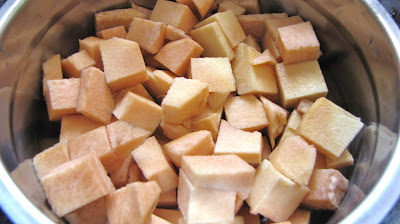The name sounds weird huh?! But ‘Ragi
Putma’ seems to me a more appropriate name because ragi puttu is made and then
converted into upma in this recipe making it Puttu+Upuma=Putma. I’ve heard of
and had ragi upma in the past, all of which included lots and lots of oil and
were tough in texture (I don’t mind the chewiness part though). I loved the taste
of it but for the oil because it almost gets cooked in oil; so I always kept
exploring on options for a less-oil ragi upma. Yesterday, I happened to search
for steamed upma and to my surprise hit many blogs that used steaming approach
for ragi upma (which is why I’m not able to quote one). This is definitely
worth a try for everyone who like and don’t like ragi. It came out very soft
and delicious.
Serves: 2
Preparation
Time: 10 min
Cooking
Time: 10 min
Ingredients:
1. Ragi
flour – 2 cups
2. Coconut
– 2 tbsp
3. Salt
to taste
4. Oil
– ½ tbsp
5. Mustard
seeds – ½ tsp
6. Urad
dal – ½ tbsp.
7. Bengal
gram – ½ tbsp.
8. Dry
chilies – 2
9. Asafoetida
– 1 pinch
10. Curry
Leaves – 1 sprig
11. Onion
– 1
12. Garlic
– 4 cloves
Method:
Step
1: Mix warm salted water to ragi flour and rub it to get moist puttu mix and
cook puttu by filling it between coconut gratings. (Elaborate explanation on
puttu making can be seen from the post ‘Puttu With Kadalai Curry’)
Step
2: When the steamed puttu has cooled down, crush it to get a course powder.
Step
3: Heat oil in a kadai: splutter mustard, fry Bengal gram & urad dal,
sprinkle asafoetida, thrown in torn curry leaves & dry chilies and sauté
the finely chopped onion & garlic in it till soft and slightly brown.
Step
4: Sprinkle some salt and add the crushed puttu and toss well. Turn off heat.
Step
5: Serve hot and eat it plain or with curds if you like.
TIPS:
*
I prepared two batches: Served the first batch with ghee, sugar & banana
and prepared upma with the other batch; that creates a balance in the palate.
*Leftover
puttu can be made into upma.
*If
serving for old people and kids, you can avoid frying dals in tadka leaving it
a very soft diet.






























